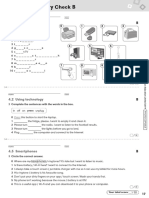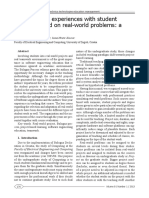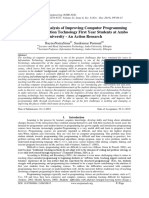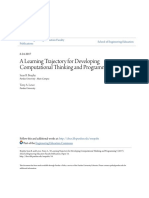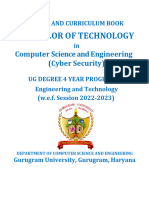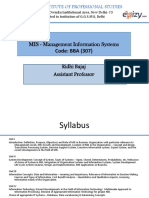Traffic Sign Recognition For Computer Vision Project-Based Learning
Traffic Sign Recognition For Computer Vision Project-Based Learning
Uploaded by
Jean Carlos VargasCopyright:
Available Formats
Traffic Sign Recognition For Computer Vision Project-Based Learning
Traffic Sign Recognition For Computer Vision Project-Based Learning
Uploaded by
Jean Carlos VargasOriginal Title
Copyright
Available Formats
Share this document
Did you find this document useful?
Is this content inappropriate?
Copyright:
Available Formats
Traffic Sign Recognition For Computer Vision Project-Based Learning
Traffic Sign Recognition For Computer Vision Project-Based Learning
Uploaded by
Jean Carlos VargasCopyright:
Available Formats
364
IEEE TRANSACTIONS ON EDUCATION, VOL. 56, NO. 3, AUGUST 2013
Traffic Sign Recognition for Computer Vision
Project-Based Learning
David Gernimo, Joan Serrat, Antonio M. Lpez, Member, IEEE, and Ramon Baldrich
AbstractThis paper presents a graduate course project on
computer vision. The aim of the project is to detect and recognize
traffic signs in video sequences recorded by an on-board vehicle
camera. This is a demanding problem, given that traffic sign
recognition is one of the most challenging problems for driving
assistance systems. Equally, it is motivating for the students given
that it is a real-life problem. Furthermore, it gives them the opportunity to appreciate the difficulty of real-world vision problems
and to assess the extent to which this problem can be solved by
modern computer vision and pattern classification techniques
taught in the classroom. The learning objectives of the course are
introduced, as are the constraints imposed on its design, such as
the diversity of students background and the amount of time
they and their instructors dedicate to the course. The paper also
describes the course contents, schedule, and how the project-based
learning approach is applied. The outcomes of the course are
discussed, including both the students marks and their personal
feedback.
Index TermsComputer vision (CV), Masters degree, projectbased learning (PBL), traffic sign.
I. INTRODUCTION
OMPUTER vision (CV) [1] is a subfield of artificial intelligence (AI) aimed at understanding still images and
video sequences; examples of this include recognizing people or
objects, navigating in an environment, reconstructing the threedimensional shape of a scene, or controlling a device (such as
when a robotic arm grasps an object). It is an interdisciplinary
field that draws from computer science, signal processing, and
a number of mathematical fields like geometry, statistics, and
algebra.
During the last two decades, CV has progressively been incorporated into both undergraduate and graduate programs of
computer science studies. In their excellent review on CV education, Bebis et al. [2] review various approaches to teaching
CV. Most of the literature is focused on different approaches
to integrating the topic into undergraduate courses. The most
common approach is to follow the traditional course structure
Manuscript received August 27, 2012; revised November 07, 2012; accepted
December 09, 2012. Date of publication February 01, 2013; date of current
version July 31, 2013. This work was supported by Dr. M. Vanrell, coordinator of the Masters Program of the Department of Computer Science, Universitat Autnoma de Barcelona, and Project Consolider-Ingenio 2010 CSD200700018. The work of D. Gernimo, J. Serrat, and A. M. Lpez was supported by
the Project TRA2011-29454-C03-01. The work of R. Baldrich was supported
by the Project TIN201021771-C02-1.
The authors are with the Computer Vision Center and the Department of Computer Science, Universitat Autnoma de Barcelona, 08193 Bellaterra, Spain
(e-mail: dgeronimo@cvc.uab.es).
Color versions of one or more of the figures in this paper are available online
at http://ieeexplore.ieee.org.
Digital Object Identifier 10.1109/TE.2013.2239997
in which the students are presented with theoretical lectures and
have short practical assignments. Another approach is to use students specific knowledge in a given area (computer graphics,
image processing, etc.) and then introduce the new CV concepts
on top. This approach assumes that the students already have
knowledge of a given topic, which is convenient for undergraduate studies in which students have to follow a given subject
itinerary. Another interesting method for teaching CV is through
interactive technology. As an example, Reimer et al. [3] propose
a tangible interface that accelerates the process of understanding
the components and results of a vision system for students who
have little experience in programming. However, while this can
be a convenient approach for undergraduate students, being able
to program and optimize the algorithms is a compulsory skill
for a graduate student. Another widely used approach is to integrate the study of computer vision with another related topic,
for example fusing robotics and CV in the same course [4]. Similarly, Hoover [5] proposes introducing computer vision topics
into an undergraduate embedded systems course. In order to attract students to the field, the introduction of image computation
in early programming classes has been proposed [6]. Finally,
one attractive approach to having the students learn the topic
is by having them carry out a CV project that solves a given
problem. This methodology, usually referred to as project-based
learning (PBL), has been used in secondary-level studies [7], engineering courses [8][14], and also graduate courses [15], this
last one being an entry-level project like the one presented here.
PBL has several advantages over the other approaches.
It allows the students to gain real experience in a topic.
It brings together theoretical and practical concepts with a
single goal, which enhances students motivation.
It allows the students to discover these new concepts for
themselves if the course is well designed.
Furthermore, PBL suits both undergraduate courses and
graduate courses in which the concepts are more advanced and
specialized.
A. Motivation
This paper presents a project-based assignment that is the
core of the Introduction to Computer Vision course of the
Masters program in CV and AI at the Universitat Autnoma de
Barcelona (UAB), Bellaterra, Spain. In this course, the students
learn the basics of computer vision: image formation, image
processing, descriptors, classification, and learning theory.
Subjects such as tracking, motion analysis, and stereo are left
to an Advanced CV course that addresses them in depth. The
course is taught during the first term together with Introduction
to AI, and followed by either Advanced CV or Advanced AI
0018-9359/$31.00 2013 IEEE
GERNIMO et al.: TRAFFIC SIGN RECOGNITION FOR CV PBL
and a more transversal course called Introduction to Research
and Development that conveys skills such as scientific writing,
ethics, and R&D project management. After completing these
courses, the students spend one term developing their Masters
thesis under the guidance of an experienced advisoreither
a university researcher or an employee of a computer vision
company. Once the students have a solid knowledge of both
theory and practice, they can then propose a thesis subject. For
more details of the Masters program, the reader can refer to
the Web site of the Masters program in Computer Vision and
Artificial Intelligence at the UAB [16].
An introductory graduate course poses several specific challenges not encountered in a typical undergraduate course. First,
the diversity of the students in terms of education and background in a graduate program is much wider than in an undergraduate course. The Masters is aimed at an international group
who may have graduated in various disciplines, from mathematics to physics to computer science or electrical engineering.
Hence, depending on their education and experience, they will
be more or less comfortable with the mathematical foundations
of computer vision, software development issues, or scientific
programming. Second, the graduate students have two types of
objectives: Some intend to pursue a Ph.D. program at the end of
their Masters, while others just want an M.Sc. degree in computer vision in order to apply for positions in IT companies. The
former are more interested in getting a sound understanding of
the theoretical basis of the current state-of-the-art techniques,
while the latter are interested in more practical matters. Third,
although graduate students are usually more motivated than undergraduates, it is of key importance to present engaging assignments that match the aforementioned objectives.
B. Proposal
To the authors knowledge, no literature exists that treats the
use of PBL to meet the traditional requirements for CV education and the graduate-oriented challenges described above.
In order to meet these challenges in the best way possible, a
unique realistic medium-sized project is proposed here: traffic
sign detection and the recognition of images extracted from
video sequences recorded while driving in urban scenarios.
Such a project requires the application of many of the low-level
image processing techniques and the key components of an
object detection/recognition system, that is, image local feature
extraction for classifier learning and evaluation. The PBL
approach presented here has three key factors that make it a
very suitable strategy to address the challenges of the course.
Although the traditional approach of using short exercises
focused on particular parts of the syllabus can be an effective knowledge acquisition technique in many courses,
PBL makes the students combine the concepts explained
in theory lectures, improving their understanding of their
application to real problems. This is an important factor
in CV students curricula. From the outset, the proposed
project tackles a complex real problem, so every new algorithm implemented to extend the system is seen by the
students as a way to improve their system, which ensures
high levels of interest and engagement. By the end of the
term, each group has a different and unique system.
365
The project begins with only a basic skeleton structure
and simple statements. Students thus gain a deeper understanding of the project and take incremental steps of progressive complexity. Each of these steps is based on concepts explained in the theory lectures.
The projects being of medium size helps to maintain a balance between giving the students a well-defined plan (i.e.,
what, when, and how to implement the mandatory techniques) and giving them the freedom to implement novel,
state-of-the-art techniques in the literature; e.g., proposing
improvements to boost the system performance.
A project designed for an introductory course such as that presented in this paper differs from a traditional final-year project
in two aspects. First, the techniques to be implemented in an introductory course are more constrained, given that the planning
and modules are predefined. Second, the systems behavior in
terms of detection performance and computational time is not
considered when assigning marks, but it is an implicit aspect
to be taken into account, as will be seen later. The aim is that
the students explore and implement the techniques explained in
theory classes and realize that these can be combined to solve
a real problem. This is in contrast to focusing on a high-performance commercial-type product, as in final-year projects.
This paper details how the project has been designed in terms
of schedule, material, and evaluation and discusses the relevant outcomes of the course during the 20112012 term. Following on from previous project-based-learning literature [8],
this paper demonstrates that PBL is an effective strategy for
teaching CV to graduate students.
The remainder of this paper is organized as follows. Section II
describes the technical details of the project to be developed by
the students, the weekly assignments, the milestones, datasets,
etc., together with the assessment methodology. Section III
summarizes the outcomes, i.e., how the course evolved in its
last offering in 20112012 and the feedback received from
students. Finally, conclusions and areas for improvement in
next years course are discussed in Section IV.
II. TRAFFIC SIGN RECOGNITION PROJECT
Traffic sign recognition (TSR), through vision or other sensors, is one of the applications belonging to the so-called advanced driving assistance systems (ADAS) field, which aims
to improve driving safety by warning the driver of potential
hazards [17][19]. The first commercial TSR systems to recognize speed limits appeared in high-end cars as recently as 2009.
However, the solution to the problem of reliably recognizing all
types of traffic signs under varying ambient lighting and weather
conditions (daytime, nighttime, rain, fog, high/low beams, etc.)
and different road types remains elusive. Modern methods, similar to other ADAS tasks [20], adopt a divide-and-conquer approach: first detection, then recognition. The output of the detection stage is a list of image bounding boxes, each containing a
yet unrecognized traffic sign, while that of the recognition stage
is a class label for each one (stop, give way, etc.), as illustrated in Fig. 1.
There are two main aspects that make TSR an ideal topic for
a PBL strategy. First, students are motivated by a present-day
technological problem, the solution to which can literally save
366
IEEE TRANSACTIONS ON EDUCATION, VOL. 56, NO. 3, AUGUST 2013
Fig. 1. Four project milestones of the traffic sign recognition prototype. Candidate generation of bounding boxes and the learned binary sign/background classifier
are combined in order to create a detection subsystem. A multiclass sign classifier takes the positive bounding boxes and assigns a traffic sign label to each one.
lives. Furthermore, being a current research problem, many of
the techniques to be tested (e.g., features, candidate generation
algorithms, etc.) are not in textbooks, but rather in recent technical articles. This trains the students to acquire knowledge from
other sources. Lecturers should also suggest up-to-date textbooks, mostly in the machine learning area [21], [22], which
may be consulted for some of the algorithms. Second, given the
modular nature of such a recognition system, the students are
encouraged to incorporate new concepts in their solutions in a
progressive manner, putting special emphasis on the path from
intuitive solutions to complex state-of-the-art ones. In addition,
the modular nature of the proposed project (containing algorithms for many different tasks, depending on the system stage)
also allows the project to cover most of the concepts studied in
the theory lectures.
Object detection problems other than TSR (e.g., pedestrian/
vehicle detection, surveillance, visual object retrieval) would
also fulfill the two aspects mentioned above. However, humandetection applications such as pedestrian detection or surveillance would be too challenging for entry-level students. Visual object retrieval is a compatible option, but TSR is by far
more attractive: The students appreciate the benefits and potential of TSR in real life, which provides extra motivation and
encouragement.
A. Schedule
The course is given over one 12-week term, with two theory
lectures of 2 h and one project session of 1 h per week. Students organize themselves in teams of three and must attend
all the sessions. The project development has four milestones,
set at the start, corresponding to the increasing functionality of
the software prototype for TSR. During the first weeks project
session, the problem is introduced, the MATLAB framework
and datasets to be used to develop the project are provided (see
the Appendix and Section II-C), and the goals (homework) for
the next week are stated, as will be done each week. Note that
the instructor does not guide the teams precisely on how to
achieve the goals; instead, they are told what the goals are and
are given some hints and explanations on the algorithms they
may use. Furthermore, the theory lectures are synchronized with
the project milestones, so the weekly homework corresponds
with the required background study.
Next, the four milestones are presented, which are illustrated
in Fig. 1 and detailed on the project Web site [23].
Candidate generation (Weeks 24). Given an input image,
candidate generation aims to propose bounding boxes
that are likely to contain a traffic sign of some type. A
bottom-up approach using the distinctive colors and geometric shapes of the signs is first suggested, which makes
students learn how to apply useful image processing
operators like color space conversions and thresholding.
Given the variability of images, some of the approaches
will most likely fail, so the students are advised to use a
top-down sliding windows algorithm (scanning the image
with all the possible candidate windows).
Binary classification (Weeks 58). Candidate generation
usually produces false positives together with the correctly
framed signs, which introduces the need for a more sophisticated filtering step. The idea is that the students start by
using very intuitive descriptors (e.g., mean grayscale) and
simple classifiers (linear discriminant analysis) and end
by testing complex features (e.g., histograms of oriented
gradients, Haar-like features, etc.) and learning machines
(support vector machines).
GERNIMO et al.: TRAFFIC SIGN RECOGNITION FOR CV PBL
Detection system (Week 9). A detection system combines
candidate generation and binary classification together
with clustering (e.g., Mean Shift) to group overlapping
positive candidates as single detections. At this milestone,
the students only have one supervision session and must
report results on whole video sequences after a 2-week
break. Developing the system is an enjoyable task they
can carry out on their own.
Recognition system (Weeks 1012). The final step consists
in upgrading from traffic sign detection to sign recognition:
deciding which specific sign (stop, give way, etc.) is
contained in each positive detection. The simplest strategy
is to apply the same binary classification algorithms as
those used in step two in the context of one versus all
multiclass classification, though more elaborate strategies
like error correcting output codes (ECOCs) are also tested
by fast-paced teams. Finally, the students have to test the
whole system on a whole video sequence, just as they did
with the detection system.
B. Weekly Work
During the course, 1 h per week is dedicated to monitoring
and giving guidance to the otherwise independent student teams.
In the first part of the session (4045 min), the results obtained
in the previous assignment are analyzed by the instructor. He
or she will provide a summary of the common problems, the
most interesting proposals, and a statistical performance of the
teams. At this point, there will also be short presentations by
the teams, submitted via e-mail beforehand, consisting of three
slides summarizing the techniques implemented, the results, and
the problems encountered. Two randomly chosen teams present
their work (it is not mandatory that all the team members speak).
This serves to facilitate communication among the groups and
allows the instructor to spend the majority of this part of the
session studying in greater depth both aspects specific to a particular team and aspects applicable to all. The instructor ensures
a balance between the interest value of the presentation for the
entire class and the frequency with which each team presents
their work. The rest of the groups also participate with comments and questions, not only on the presenting teams work,
but also with respect to their own systems. The submitted work
is not evaluated weekly, but at the milestone checkpoints (see
Section II-C).
In the second part of the session (1520 min), the homework
for the next week is explained. Usually, this is quite straightforward: The main ideas plus the evaluation criteria are explained,
and since the required theoretical concepts are still fresh from
the recent lectures, there are few questions. If any concept has
not been explained (e.g., sliding windows), it is described in detail in this part of the session. In addition, the instructor gives
special instructions on the algorithms that are particularly complicated to implement (e.g., integral image). Finally, it is worth
noting that during the semester, the instructor has one additional hour per week for answering questions from individual
groups or students, during which they can analyze their systems
in greater depth.
367
Fig. 2. Samples from seven of the 14 traffic sign types learned by the multiclass
classifier for sign recognition.
C. Dataset
The students are provided with a dataset of images both
to facilitate the testing of each milestone and to serve as a
common benchmark for all teams. In addition, they are freed
from creating a manually annotated ground-truth set for detection and recognition, which would be very time-consuming.
The dataset used for the project is based on the KUL traffic
sign database [24], [25] created by Dr. Radu Timofte from
the Katholieke Universiteit of Leuven, Leuven, Belgium. The
dataset was adapted to the specific needs of the project, selecting the number of images and those traffic sign types with
more samples. Three subsets are provided to the students:
Detection set: 669 images of 1628 1236 pixels, with annotated ground-truth (bounding boxes and type of traffic
signs present in the image) used in the candidates generation and detection/recognition systems milestones;
Classification set: cropped images to be used for the binary
classifier training and testing. In total, 3000 images in five
groups (circles, inverted triangles, rectangles, octagons and
triangles) plus a background subset;
Recognition set: This is divided into training and testing
and is used to build the multiclass classifier that recognizes
the traffic sign type. The set is limited to 14 types of signs
(Fig. 2), those with more samples. The size of this set is
1225 images.
The final recognition system, in addition to being evaluated on the detection set, is tested on a short sequence
(200 frames) from the KUL dataset and on a challenging sequence (185 frames) from the CVC-02 pedestrian dataset [26].
The latter was recorded with a different camera in a different
country (Spain) and thus contains slightly different signs and
imaging conditions.
D. Evaluation
The project is graded as follows: 20% for each of the four
milestone deliverables, 10% for two oral presentations, and 10%
for peer evaluation. This amounts to 55% of the total course
score, the remaining 45% being determined with a written exam.
Teams are evaluated at the four project milestones based on
their deliverables. These consist of a 10-page report plus the
source code of the corresponding project part. Each weekly
assignment is graded with an E (not submitted), D (failed),
C (meets mandatory requirements), B, or A (exceeds mandatory requirements).1 During the first weeks, it is the instructor
who suggests ways to go beyond the mandatory work. Subsequently, the students propose their own approaches, whose
complexity and originality will determine their grade. As an
1For inclusion in their total marks for the course, students project grades are
,
,
,
, and
.
converted to marks as:
368
IEEE TRANSACTIONS ON EDUCATION, VOL. 56, NO. 3, AUGUST 2013
example, the homework in week 8 consists of testing the
performance of
on the classification dataset,
which is the minimum requirement to get a C. Getting an A
or a B depends on students incorporating proposed improvements: the use of different color spaces to compute the HOG
descriptor would be graded with a B, while the implementation
of different visual featurese.g., local binary pattern (LBP),
shape context, distance to border (DtB), or scale invariant
feature transform (SIFT)or the implementation of multipart
classification would be graded with an A.
One of the course objectives is to have the students explore
many of the different techniques explained in the theory lectures. The idea of evaluating the teams exclusively according
to practical issues like fast processing and detection rates was
discarded. In fact, the computation time restriction is naturally
limited by their having to present their results weekly, which
forces them to optimize their algorithms. In addition, simply
providing the teams performance statistics fosters competition
and thereby boosts variety of the solutions.
In the first deliverable, the length or organization of the report
is not evaluated. Instead, the idea is to make the students explain and assess the implemented techniques. From the second
milestone on, once students have already settled their frameworks and feel comfortable with the technical part, technical
writing is also evaluated: document organization, comprehensiveness, style, references, and synthesis. Some of these concepts are taught in the parallel Masters course Introduction to
R&D [16]. The students are provided with a set of technical
writing guidelines and a LaTeX template.
Each team has to make two 10-min oral presentations, with a
further 5 min for discussion during which all the members are
required to speak. The first presentation is on the candidate generation milestone and the second on the detection or the recognition part. These presentations serve to evaluate two different
skills necessary for any engineer: technical soundness and communication. The technical aspects are assessed by the instructor,
while the oral presentation aspects (vocabulary, grammar, expression) are assessed by an English language instructor. Each
member of the group has to present a part of their work, but the
final mark is not set individually.
Finally, each student is provided with a confidential form to
assess the contribution to the project of each of his/her team
partners. This consists of simple, direct, unambiguous, multiple-choice statements such as Student X worked more/same/
less than me. In this way, the chances of getting an irrelevant or
biased evaluation is minimized. This evaluation is also useful
to identify students who do not contribute sufficiently to the development of the project, in which case they can be penalized
in their marks or have an individual evaluation.
III. DISCUSSION
This section presents the outcomes of the course for the
20112012 year. They are divided as follows: an analysis of
grades and student feedback, remarks from the instructors
that are likely to be useful for educators willing to implement
similar courses in their institutions, and issues regarding the
students performance in the theory exam.
Fig. 3. (top) Distribution of the students marks after taking into account deliverables, oral presentations, and intragroup evaluation. (bottom) Distribution
of the grades (see legend) of the deliverables at each milestone.
A. Marks
Fig. 3 (top) shows the distribution of the final student marks
according to the weighting specified in Section II-D. As can be
seen, the marks are high (a mean average of 8.42 and a standard deviation of 1.08 over 10), which means that in general
the teams fulfilled most of the requirements and proposed interesting improvements. Fig. 3 (bottom) illustrates the increase
in most teams grades during the four stages. This increase is
due to two factors. First, the students initially had to adapt to
the weekly milestones scheme, the working framework, and the
language (while almost everybody had medium or high programming skills, 44% of the students had little experience in
MATLAB). Second, they required the first evaluation to understand the type and extent of improvements they had to implement in order to obtain the highest marks.
B. Student Feedback
The feedback from the students was very good. They were
engaged by the weekly assignments and enjoyed the project in
spite of the amount of work it represented. An indication that the
course succeeded in motivating students is that several of them
changed their enrolment from Advanced AI to the Advanced CV
course for the second term of the year.
At the end of the course, the students were asked to fill
in an anonymous assessment form on the project. Based on
this form and on personal communication, some interesting
issues are worth highlighting. On the one hand, the students
valued the continuity of the project, its relevance to the theory
lectures (68%), and the appropriate level of difficulty (87%),
the latter being one of the main concerns during its design. On
the other hand, while the discussion sessions were very highly
valued with respect to their usefulness in developing the project
(93%), some students complained of insufficient time being
dedicated to the explanation of the weekly homework and the
subgoals during these sessions (37%). Keeping an appropriate
GERNIMO et al.: TRAFFIC SIGN RECOGNITION FOR CV PBL
balance between the time spent in discussion and homework
explanations is difficult. In fact, the better-performing teams
wanted more discussion on the improvements presented by
other groups, which could help them to learn new techniques
and methods for their experiments. Other teams preferred a
longer and more detailed explanation of the mandatory homework to be done by the next week.
Another popular complaint concerned the ambiguity when
evaluating the work, specifically the difference between A and
B grades. While the students were informed at the beginning of
the course that the grading policy would take into account additional improvements (i.e., a subjective mark depending on the
complexity), some teams who implemented minimum improvements were not satisfied with their marks being lower than those
for teams with much more relevant proposals. This was rapidly
amended by stating specific objectives to be met to achieve the
possible improvements. For instance, in week 9 (sign detection
task), the number of required implementations of candidate generation and classification algorithms for the B and C grades was
specified, instead of leaving it open, and A was reserved for very
original proposals, such as the use of a new feature descriptor
or using part-based classification.
The students also provided information about the time they
spent on the project each week: 6% spent from 5 to 10 h, 38%
from 10 to 15 h, 25% from 15 to 20 h, and 31% spent more than
20 h a week on the project. Given that the whole course is worth
10 ECTS (25 hours per ECTS credit), which corresponds to
around 50 h of lectures and 200 h of work out of class, these figures suggest an appropriate correspondence between the ECTS
available and the students effort.
C. Instructors Remarks
The oral presentations were too tiring for both instructors
and students due to the number of teams, the limited time, and
the similar content being presented, in addition to the instructors being too generous in presentation timing. This should be
amended in future offerings.
Specifying a clear penalty when deadlines are not met is also
an important point. Given that there are fewer groups than in an
undergraduate course, the due dates were sometimes extended.
By clearly stating the penalty (e.g., late submissions are not accepted), evaluation becomes easier for the instructor and fairer
to the students.
Finally, in future courses, it would be desirable to go into
more detail on topics that were only touched upon, such as the
suitability of the different evaluation measurements, or the analysis of performance curves and limit the treatment of others,
such as template matching or linear discriminant analysis.
D. Theory Exam
Although the students became very capable of analyzing a
real problem and solving it (managing overfitting, dealing with
ground-truth limitations, researching current literature, etc.),
their marks in the theory exam were unexpectedly low (a mean
average of 4.53 with a standard deviation of 1.87) and had
low correlation with the project marks (0.3). While this paper
focuses on a PBL project and not on the theoretical part of
the course, it is worth analyzing the ways in which the project
369
could be modified to improve the students performance in the
exam.
First, it is clear that the project is more engaging to students
than are theoretical studies, but it is also time-consuming.
Therefore, at the end of each week, they may have greatly improved their system, but also may have ignored the theoretical
part of the course to some extent. Second, some of the answers
in the exam suggest that although the students understand the
techniques while implementing them for the project, they do
not really understand their relevance in spite of their being
highly related to the theory. While it is virtually essential to put
theory into practice in order to master it, it is also important
to ensure that the theoretical concepts behind the practical applications are understood in order to obtain a solid knowledge
of the subject. These problems could be resolved in part by
eliminating elements of the project, such as assignments in the
candidate generation or classification stages, and/or some of the
reports or oral presentations. This would not affect the structure
and attractiveness of the project and would allow the inclusion
of midterm theory exams. This would not only leave students
more time for studying, but would also motivate them to learn
the theory behind the implemented techniques, which is what
will be evaluated in the exam. Furthermore, the inclusion of
some project-related problems focused on the theoretical foundations of the implemented techniques would also encourage
the students to study more theory. These problems could also
be used as an additional part of the evaluation.
IV. CONCLUSION
A project on traffic sign detection and recognition for an introductory computer vision graduate course has been presented.
The outcomes of the 20112012 year were excellent: The students were satisfied both with their results and with the variety
of techniques they had put into practice, most of them related
to the theory lectures. By the end of the course, they have developed a relatively complex vision system, having researched
numerous CV fields, and written a number of scientific and technical documents.
The three main aspects that should be considered by educators aiming to implement similar PBL approaches at graduate
level are as follows.
First, an analysis of the course syllabus and the skills to
be acquired by the students is crucial when deciding if
PBL is the most convenient approach. The ideal case involves a wide syllabus containing concepts with direct implementation, in which practical experience of programming and teamwork are basic required skills. On the contrary, courses with very theoretical or specialized syllabi
should be implemented using approaches more focused on
exams or with a number of separate practical assignments,
respectively.
Second, current-day real-life problems not only motivate
the students, with a subsequent improvement of their expected results, but also emphasize the need to understand
the theoretical concepts to develop the project. In addition,
they also require the students to read research articles in addition to textbooks, a desirable skill for graduate students.
370
IEEE TRANSACTIONS ON EDUCATION, VOL. 56, NO. 3, AUGUST 2013
TABLE I
THEORY AND PROJECT CONTENTS OF THE COURSE. PERFEVALPIX AND PERFEVALOBJ ARE INTRODUCED IN WEEKS 2 AND 3 AND THEN USED THROUGHOUT
THE COURSE
Finally, planning the project so that the students encounter
the concepts naturally, as they carry it out, is the most suitable approach. Most of the systems can be divided into
different stages that can be used as guidelines to plan and
schedule the theoretical lectures. This aspect is perhaps the
most difficult to be implemented: to make the first algorithms based on educated guesses, while the new solutions
are built on top of their predecessors. PBL represents the
most convenient approach to tackle this aspect, but the instructors have to take into account the characteristics of
the student demographic (e.g., different backgrounds), the
course level (e.g., degree), and the coverage of the theory
contents in order to tailor the courses design to the specific
requirements.
The complete project materials have been made public on the
project Web site [23]. They may serve either as an inspiring
resource for other educators together with the experience described in this paoer, or they can be directly applied not only
in other graduate CV courses, but also in pattern recognition or
machine learning courses, just as when adopting a textbook as a
course guide. The proposed project is the result of the authors
experience during 5 years in graduate education, the thorough
design of the plan, templates, rubrics, and datasets to implement
such a project. Supporting the effectiveness of this project design, these materials were successfully used by other instructors from the same institution in the 20122013 offering of the
course, who found the preparatory work to have been much less
than expected thanks to the materials provided and the detailed
course organization.
APPENDIX
Material publicly available to students and instructors [16]:
project assignment;
project planning and contents;
templates and documents: progress slides, report, intragroup evaluation;
rubrics: reports and oral presentations;
source code: MATLAB skeletons (detector and classifier),
third-part MATLAB code from MathWorks and other
sources (Circular Hough, Colorpsace, Harris, HOG, LDA,
LibSVM, MeanShift);
datasets: detection, classification, recognition, and video
sequences (based on KUL Dataset [24], [25]).
Table I lists the contents of the theory classes and the project
(note that week 12 is reserved for study time for the exam).
ACKNOWLEDGMENT
The authors would like to thank Dr. R. Timofte for making
the KUL Belgium Traffic Signs and Classification Benchmark
datasets publicly available. These datasets were subsequently
adapted for teaching purposes.
REFERENCES
[1] R. Szeliski, Computer Vision: Algorithms and Applications. New
York, NY, USA: Springer, 2010.
[2] G. Bebis, D. Egbert, and M. Shah, Review of computer vision education, IEEE Trans. Educ., vol. 46, no. 1, pp. 221, Feb. 2003.
[3] P. Reimer, A. Albu, and G. Tzanetakis, Raydiance: A tangible interface for teaching computer vision, in Proc. 7th ISVC, Las Vegas, NV,
USA, 2011, vol. 2, pp. 259269.
[4] G. Cielniak, N. Bellotto, and T. Duckett, Integrating mobile robotics
and vision with undergraduate computer science, IEEE Trans. Educ.,
vol. 56, no. 1, pp. 4853, Feb. 2013.
[5] A. Hoover, Computer vision in undergraduate education: Modern embedded computing, IEEE Trans. Educ., vol. 46, no. 2, pp. 235240,
May 2003.
[6] C. Olson, Encouraging the development of undergraduate researchers
in computer vision, ACM SIGCSE Bull., vol. 44, no. 2, pp. 255259,
2006.
[7] R. Capraro and S. Slough, Project-Based Learning. Rotterdam, The
Netherlands: Sense, 2009.
[8] L. Fernandez-Samaca and J. Ramrez, An approach to applying
project-based learning in engineering courses, in Proc. IEEE ANDESCON, Botot, Colombia, 2010, pp. 16.
[9] A. Price, R. Rimington, M. T. Chew, and S. Demidenko, Projectbased learning in robotics and electronics in undergraduate engineering program setting, in Proc. IEEE Int. Symp. Electron. Design,
Test, Appl., Ho Chi Minh City, Vietnam, 2010, pp. 188193.
[10] R. Hsu, Project based learning as a pedagogical tool for embedded
system education, in Proc. 3rd Int. Conf. Inf. Technol., Res. Educ.,
Hsinchu, Taiwan, 2005, pp. 362366.
[11] J. Macias-Guarasa, A project-based learning approach to design
electronic systems curricula, IEEE Trans. Educ., vol. 49, no. 3, pp.
389397, Aug. 2006.
[12] J. Venkataraman, Project based electromagnetics education, in Proc.
Appl. Electron. Conf., 2009, pp. 14.
[13] A. Breiter, G. Fey, and R. Drechsler, Project-based learning in student
team in computer science education, Electron. Energetics, vol. 18, no.
2, pp. 165180, 2005.
[14] F. Martinez, L. Herrero, and S. de Pablo, Project-based learning and
rubrics in the teaching of power supplies and photovoltaic electricity,
IEEE Trans. Educ., vol. 54, no. 1, pp. 8796, Feb. 2011.
[15] J. Nelson, Using project-based assignments in graduate-level digital
signal processing course, in Proc. Digital Signal Process. Workshop
& 4th IEEE Signal Process. Educ. Workshop, 2006, pp. 135140.
[16] Universitat Autnoma de Barcelona, Bellaterra, Spain, Website of the
UAB Master on Computer Vision and Artificial Intelligence, 2012
[Online]. Available: http://mcvai.uab.cat
[17] J. Khan, S. Bhuiyan, and R. Adhami, Image segmentation and shape
analysis for road-sign detection, IEEE Trans. Intell. Transport. Syst.,
vol. 12, no. 1, pp. 8396, Mar. 2011.
GERNIMO et al.: TRAFFIC SIGN RECOGNITION FOR CV PBL
[18] S. Maldonado-Bascn, S. Lafuente-Arroyo, P. Gil-Jimnez, H.
Gmez-Moreno, and F. Lpez-Ferreras, Road-sign detection and
recognition based on support vector machines, IEEE Trans. Intell.
Transport. Syst., vol. 8, no. 2, pp. 264278, Jun. 2007.
[19] A. de la Escalera, J. Armingol, and M. Mata, Traffic sign recognition
and analysis for intelligence vehicles, Image Vision Comput., vol. 21,
pp. 247258, 2003.
[20] D. Gernimo, A. Lpez, A. Sappa, and T. Graf, Survey of pedestrian
detection for advanced driver assistance systems, IEEE Trans. Pattern
Anal. Mach. Intell., vol. 32, no. 7, pp. 12391258, Jul. 2010.
[21] C. Bishop, Pattern Recognition and Machine Learning. New York,
NY, USA: Springer-Verlag, 2006.
[22] D. Forsyth, Computer Vision: A Modern Approach. Upper Saddle
River, NJ, USA: Prentice Hall, 2011.
[23] D. Gernimo, M.Sc. project Website 2012, 2012 [Online]. Available:
http://mcvai.uab.cat/content/mscproject2012
[24] R. Timofte, KUL Belgium traffic signs and classification benchmark
datasets, 2012 [Online]. Available: http://homes.esat.kuleuven.be/
~rtimofte
[25] R. Timofte, K. Zimmermann, and L. Van Gool, Multi-view traffic sign
detection, recognition, and 3D localisation, Mach. Vision Appl., 2011.
[26] D. Gernimo, CVC-02 pedestrian dataset, 2009 [Online]. Available:
http://www.cvc.uab.es/adas/datasets
David Gernimo received the B.Sc. degree in computer science and M.Sc. degree and Ph.D. degree (with honors) in computer vision from the Universitat
Autnoma de Barcelona (UAB), Cerdanyola, Spain, in 2004, 2006, and 2010,
respectively.
He is currently a Postdoctoral Researcher and Associate Lecturer with the
Computer Science Department, UAB, and the Computer Vision Center. His research interests include object detection, recognition and tracking, feature detection and description, and scene understanding.
371
Joan Serrat received the Ph.D. degree in computer science from the Universitat
Autnoma de Barcelona (UAB), Bellaterra, Spain, in 1990.
He is currently an Associate Professor with the Computer Science Department, UAB, and a member of the Computer Vision Center. At UAB, he is in
charge of two undergraduate courses on Software Engineering and Image Processing and co-coordinates the introductory module of the Master on Computer
Vision. He has coauthored more than 40 papers and three patents. His current
research interest is the application of probabilistic graphical models to computer
vision problems such as feature matching, tracking, and video alignment.
Dr. Serrat has been a Board Member of the Spanish Chapter of the International Association for Pattern Recognition.
Antonio M. Lpez (M10) received the B.Sc. degree in computer science from
the Universitat Politcnica de Catalunya (UPC), Barcelona, Spain, in 1992, and
the M.Sc. and Ph.D. degrees in image processing and artificial intelligence from
the Universitat Autnoma de Barcelona (UAB), Bellaterra, Spain, in 1994 and
2000, respectively.
Since 1992, he has been giving lectures with the Computer Science Department, UAB, where he currently is an Associate Professor. In 1996, he participated in the foundation of the Computer Vision Center at the UAB, where he has
held different institutional responsibilities, currently leading the research group
on advanced driver assistance systems (ADAS) by computer vision. He has led
public and private projects and is a coauthor of more than 100 papers, all in the
field of computer vision.
Ramon Baldrich received the Ph.D. degree in computer science from the Universitat Autnoma de Barcelona (UAB), Bellaterra, Spain, in 2001.
He is an Associate Professor with the Computer Science Department, UAB,
and is attached to the Computer Vision Center as a Researcher. His research
interests are mainly focused in color treatment in computer vision problems,
including color constancy, color induction, and image shadows.
You might also like
- Go Getter 3 TestsDocument1 pageGo Getter 3 TestsJulia Balashova100% (2)
- Mach3 Oem CodeDocument61 pagesMach3 Oem CodeAdalbert Júnior57% (7)
- EX - NO:1 Write A Code Simulating ARP /RARP Protocols: Aim: Algorithm: ServerDocument25 pagesEX - NO:1 Write A Code Simulating ARP /RARP Protocols: Aim: Algorithm: ServerSuba Sri100% (1)
- IPC9850Document56 pagesIPC9850Carlos Mascioni100% (1)
- NP-Completene S S For All Computer Science Undergraduates: A Novel Project - Based CurriculumDocument13 pagesNP-Completene S S For All Computer Science Undergraduates: A Novel Project - Based CurriculumPrakash BalaNo ratings yet
- Outcome-Based Teaching and Learning in Computer SCDocument8 pagesOutcome-Based Teaching and Learning in Computer SCPandurang UpparamaniNo ratings yet
- M.Tech (CSE) : Lovely Professional UniversityDocument6 pagesM.Tech (CSE) : Lovely Professional Universitygm442No ratings yet
- CS Principles Curriculum Framework 2013-08-20Document30 pagesCS Principles Curriculum Framework 2013-08-20osmincitofNo ratings yet
- 2122 6150 MSC Data ScienceDocument7 pages2122 6150 MSC Data ScienceGaayu SatyanNo ratings yet
- Hybrid Projet Based Learning in Computer VisionDocument13 pagesHybrid Projet Based Learning in Computer VisionElla AndhanyNo ratings yet
- 618195.fertalj Milasinovic Nizetic Ttem 8 1Document11 pages618195.fertalj Milasinovic Nizetic Ttem 8 1MICHELLE ALEJANDRA BACA GUZMANNo ratings yet
- Grade 11 Programming Research PDFDocument10 pagesGrade 11 Programming Research PDFTanya MiyaNo ratings yet
- SE and CS Collaboration: Training Students For Engineering Large, Complex SystemsDocument8 pagesSE and CS Collaboration: Training Students For Engineering Large, Complex SystemsrecluzeNo ratings yet
- Capstone Writing ServiceDocument3 pagesCapstone Writing ServiceNatasha ReynoldsNo ratings yet
- Towards Practical C++ Programming Projects For Pre-University Engineering StudentsDocument13 pagesTowards Practical C++ Programming Projects For Pre-University Engineering StudentsComputer ActivityNo ratings yet
- Teaching and Learning in STEM With Computation, Modeling, and Simulation Practices: A Guide for Practitioners and ResearchersFrom EverandTeaching and Learning in STEM With Computation, Modeling, and Simulation Practices: A Guide for Practitioners and ResearchersNo ratings yet
- A Project-Based Learning Design For Teaching and Learning of Mechatronics EngineeringDocument6 pagesA Project-Based Learning Design For Teaching and Learning of Mechatronics Engineeringalejandro perdomoNo ratings yet
- A Teaching Methodology For Introductory Programming Courses Using AliceDocument4 pagesA Teaching Methodology For Introductory Programming Courses Using AliceIJMERNo ratings yet
- Linking Mathematics and Image Processing Through Common TerminologiesDocument10 pagesLinking Mathematics and Image Processing Through Common TerminologiesThammie Christy SaibinNo ratings yet
- Teaching Web Application Development: A Case Study in A Computer Science CourseDocument16 pagesTeaching Web Application Development: A Case Study in A Computer Science CourseSandhyaNo ratings yet
- Enhancing Learning Outcomes and Student Engagement in Object-Oriented Programming: A Comparative Analysis of Teaching Methods .Document17 pagesEnhancing Learning Outcomes and Student Engagement in Object-Oriented Programming: A Comparative Analysis of Teaching Methods .sheraffinNo ratings yet
- Object-Oriented Programming in BulgarianDocument14 pagesObject-Oriented Programming in BulgarianGILDA GODEANUNo ratings yet
- Projects in Department Wide Junior Civil Engineering CoursesDocument22 pagesProjects in Department Wide Junior Civil Engineering CoursesRodney MahlanguNo ratings yet
- Sample Thesis For Computer Engineering StudentsDocument6 pagesSample Thesis For Computer Engineering StudentsBuy-Essay-Springfield100% (1)
- A Capstone Course On Agile Software Development Using ScrumDocument9 pagesA Capstone Course On Agile Software Development Using ScrumLenin OrmazaNo ratings yet
- Curriculum of The MSC Program in Computer Science Jan 2005Document20 pagesCurriculum of The MSC Program in Computer Science Jan 2005Tsegaye HailuNo ratings yet
- Introducing Computer Science Fundamentals Before ProgrammingDocument5 pagesIntroducing Computer Science Fundamentals Before ProgrammingMichael OrozcoNo ratings yet
- A Practice Learning of On Board Diagnosis Obd Implementations With Embedded SystemsDocument12 pagesA Practice Learning of On Board Diagnosis Obd Implementations With Embedded SystemsKefin TajebNo ratings yet
- Ristov 2016Document6 pagesRistov 2016sukmaaji.idNo ratings yet
- Guideline Format of Major Project ReportDocument20 pagesGuideline Format of Major Project ReportAmeer JoshiNo ratings yet
- B.SC (AM) 20212608Document116 pagesB.SC (AM) 20212608Renz Diego AngelesNo ratings yet
- Dmoore Final Project ProposalDocument5 pagesDmoore Final Project Proposalapi-277136318No ratings yet
- BCA-syllabus-for-1-to-4-to-semDocument54 pagesBCA-syllabus-for-1-to-4-to-semruthvikgv448No ratings yet
- 171557-Article Text-440396-1-10-20180521Document11 pages171557-Article Text-440396-1-10-20180521Angel CastilloNo ratings yet
- Guidelines For FYPDocument12 pagesGuidelines For FYPHaiderAliNo ratings yet
- University of Cagayan ValleyDocument5 pagesUniversity of Cagayan ValleyRandy TabaogNo ratings yet
- Syllabus - Introduction To Data Visualization - Summer 2021Document7 pagesSyllabus - Introduction To Data Visualization - Summer 2021mcbenmahdiNo ratings yet
- B.sc. (IT) 3 Years Syllabus 2022Document124 pagesB.sc. (IT) 3 Years Syllabus 2022mani kumarNo ratings yet
- JEET1057Document6 pagesJEET1057DeadSouL OPNo ratings yet
- Martins Et Al-2018-Computer Applications in Engineering EducationDocument13 pagesMartins Et Al-2018-Computer Applications in Engineering Educationlobito71No ratings yet
- BSC CSDocument114 pagesBSC CSkarthikeyanNo ratings yet
- Incorporating Engineering Applications Into Calculus InstructionDocument11 pagesIncorporating Engineering Applications Into Calculus InstructionRita VazquezNo ratings yet
- Small Is Beautiful: Embedded Systems Projects in An Undergraduate Software Engineering ProgramDocument7 pagesSmall Is Beautiful: Embedded Systems Projects in An Undergraduate Software Engineering ProgramM. Priyono Tri SulistyantoNo ratings yet
- Educon 14 PDFDocument6 pagesEducon 14 PDFCharlotte Marcos LacernaNo ratings yet
- 21CS63 - CG&FIP Course MaterialDocument151 pages21CS63 - CG&FIP Course MaterialnamrathabramheriNo ratings yet
- DS83 115Document6 pagesDS83 115Paula Andrea Vargas MarinNo ratings yet
- A First Year Power Plant Design ProjectDocument14 pagesA First Year Power Plant Design ProjectMohammed Imran HossainNo ratings yet
- Dmoore Final Project DocumentationDocument4 pagesDmoore Final Project Documentationapi-277136318No ratings yet
- Bachelor Thesis HFT StuttgartDocument5 pagesBachelor Thesis HFT StuttgartSimar Neasy100% (1)
- B2106010815Document8 pagesB2106010815Waqas AhmedNo ratings yet
- Computer Technology For Enhancing Teaching and Learning Modules of Engineering MechanicsDocument14 pagesComputer Technology For Enhancing Teaching and Learning Modules of Engineering Mechanicspasha.baileyNo ratings yet
- Programming For Civil and Building Engineers Using MatlabDocument9 pagesProgramming For Civil and Building Engineers Using MatlabNafees ImitazNo ratings yet
- Sample Thesis Title Civil EngineeringDocument4 pagesSample Thesis Title Civil Engineeringdwnt5e3k100% (2)
- A Learning Trajectory For Developing Computational Thinking and PDocument11 pagesA Learning Trajectory For Developing Computational Thinking and PNancy Al-AssafNo ratings yet
- Curriculum For Bachelor (BSC) in Robotics: Aalborg University September 2014Document34 pagesCurriculum For Bachelor (BSC) in Robotics: Aalborg University September 2014Jose CabusNo ratings yet
- Energi Bangunan TerbarukanDocument15 pagesEnergi Bangunan TerbarukanDEEGER MILDNo ratings yet
- Computer Science Dissertation MethodologyDocument7 pagesComputer Science Dissertation MethodologyWriteMyPaperApaStyleLasVegas100% (1)
- MSC Mechanical Engineering Thesis TopicsDocument6 pagesMSC Mechanical Engineering Thesis Topicsoabfziiig100% (2)
- U18 B.SC - Computer ScienceDocument100 pagesU18 B.SC - Computer Sciencesgprakash447No ratings yet
- BRM OutlineDocument12 pagesBRM Outlinetxx19309No ratings yet
- Smrithi Seet Icse2014 1Document8 pagesSmrithi Seet Icse2014 1csvsmrithiNo ratings yet
- MSC E-Learning Technology: School of Computer ScienceDocument6 pagesMSC E-Learning Technology: School of Computer SciencetimsoftNo ratings yet
- My Whole SyllabusDocument184 pagesMy Whole SyllabusSwanNo ratings yet
- Teaching Software Designing Skills: Judith Gal-EzerDocument12 pagesTeaching Software Designing Skills: Judith Gal-EzerBamidele Alexander ObaNo ratings yet
- SCAFE Billling RatesDocument1 pageSCAFE Billling RatesPujan NeupaneNo ratings yet
- Panel Conventional 4006Document8 pagesPanel Conventional 4006Abdul JabarNo ratings yet
- Log Surat Keterangan SehatDocument100 pagesLog Surat Keterangan SehatmasdanoNo ratings yet
- Athesi: Mob Le Generat OnDocument3 pagesAthesi: Mob Le Generat Ontristanleboss2No ratings yet
- 1 Acmt All in OneDocument1,030 pages1 Acmt All in Onejearl007100% (2)
- Project Synopsis 4th SemDocument6 pagesProject Synopsis 4th SemCSD70 Vinay SelwalNo ratings yet
- Chapter 1 MechanismDocument82 pagesChapter 1 MechanismMohsan AbbasNo ratings yet
- CheetahPerc JKM380-400M-72H-V-A1-EN PDFDocument2 pagesCheetahPerc JKM380-400M-72H-V-A1-EN PDFJorge RodriguezNo ratings yet
- SM-Biopass PKI Token: Securemetric TechnologyDocument2 pagesSM-Biopass PKI Token: Securemetric TechnologyFier SKNo ratings yet
- Untas Herianto, STDocument6 pagesUntas Herianto, STHerianto UntasNo ratings yet
- Two Stroke EngineDocument16 pagesTwo Stroke EngineÁdám CseryNo ratings yet
- Traffic ManagementDocument6 pagesTraffic Managementroncarl29No ratings yet
- Organizing Conversations About "New Media": Towards A Theory of Digital Communication.Document17 pagesOrganizing Conversations About "New Media": Towards A Theory of Digital Communication.Carlos A. Scolari100% (1)
- Process Safety Management Initial TrainingDocument20 pagesProcess Safety Management Initial TrainingAwad AbdallaNo ratings yet
- MTSC Mec-Dwg-Cpc-Dfd-D&e-M - 00-2Document1 pageMTSC Mec-Dwg-Cpc-Dfd-D&e-M - 00-2Joenald SisonNo ratings yet
- Simulation XDocument7 pagesSimulation XAdib RizqullohNo ratings yet
- EXP2 Half Wave RectifierDocument3 pagesEXP2 Half Wave RectifierMohammed Dyhia Ali50% (2)
- 500-12 - EltDocument2 pages500-12 - Eltgaetan.boehlyNo ratings yet
- MIS - Management Information Systems: Code: BBADocument23 pagesMIS - Management Information Systems: Code: BBAPuja AryaNo ratings yet
- SAP Forum - FMS Kering Eyewear Project - V4.5Document16 pagesSAP Forum - FMS Kering Eyewear Project - V4.5AndreasJauchMeyrinch100% (1)
- Computer ViruesDocument19 pagesComputer ViruesMuhammad Adeel AnsariNo ratings yet
- Ford Motor Company: Supply Chain Strategy: Submitted To DR - Jagadeesh RDocument17 pagesFord Motor Company: Supply Chain Strategy: Submitted To DR - Jagadeesh RDavis Nadakkavukaran SanthoshNo ratings yet
- Test Report 116712Document51 pagesTest Report 116712Caner KURTNo ratings yet
- TWINCVI3 V 1.7.2.X - User Manual - EN - 6159939211-07-Series - EN PDFDocument76 pagesTWINCVI3 V 1.7.2.X - User Manual - EN - 6159939211-07-Series - EN PDFRicardo VegaNo ratings yet
- Aicte Neyveli Data SciencesDocument3 pagesAicte Neyveli Data Sciencessaran20099No ratings yet
- Documentation Checklist - What The New IT Guy Needs To Find OutDocument2 pagesDocumentation Checklist - What The New IT Guy Needs To Find OutchindukNo ratings yet
